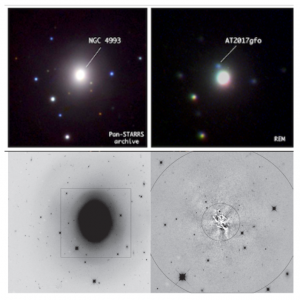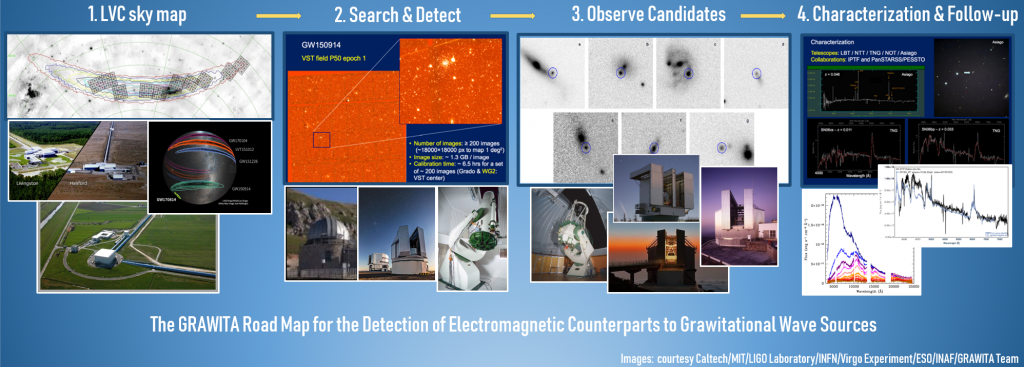The GRAWITA Collaboration (GRAvitational Wave Inaf TeAm) includes a hundred of INAF researchers led by Enzo Brocato, with the aim to search, monitor and study the electromagnetic (EM) counterparts of gravitational wave (GW) sources detected and identified by the interferometer network, which currently includes the two installations located respectively in the state of Washington and Louisiana in the US (the Advanced-LIGO, Laser Interferometer Gravitational-Wave Observatory) and the Advanced-Virgo detector located in Pisa, Italy.
Soon after a gravitational wave signal has been detected by the LIGO-Virgo interferometers, the GRAWITA collaboration, immediately starts observational campaigns in the optical, near infrared, radio and X-ray bands, using the most advanced satellites and ground-based telescopes positioned all over the world, such as the VLT Survey Telescope (VST: Chile), the Large Binocular Telescope (LBT: United States, Arizona), the Galileo National Telescope (TNG: Spain, Canary ), the Rapid Eye Mount Telescope (REM: Chile), and the Sardinia Radio Telescope (SRT), the telescopes at Asiago and at Campo Imperatore in Italy. In September 2015, the LIGO-Virgo Collaboration has measured a gravitational wave signal, an event which opened the opportunity to study the universe using a new “information” messenger, different from the electromagnetic light: it is the era of ‘Multi-messenger astronomy.

On August 17, 2017, a short GW signal lasting about 50 seconds (GW170817) was revealed by Ligo-Virgo. A few seconds later, the Fermi and Integral satellites “saw” a brief gamma radiation flash. The extensive observational campaign prompted by these two events led to the identification of the first electromagnetic counterpart source (called AT2017gfo) of a gravitational wave signal, originating from the coalescence of two neutron stars bound in a binary system (Abbott et al. 2017 Phys. Review). The GRAWITA team, together with researchers from other national and international institutes, observed the source for several days, from August to September, with photometric follow-up campaigns performed with REM, ESO-VST and ESO-VLT telescopes, in a wide wavelength range (3200–24800 Angstrom). In particular, the unique images provided by the VST telescope made it possible to reveal the existence of a “Kilonova” in the galaxy NGC4993, the origin of the gravitational signal. A kilonova is a transient source, whose energy comes from the radioactive decay of heavy elements produced by the nucleosynthesis “r” processes, during the coalescence process.
The researchers of the INAF-Astronomical Observatory of Abruzzo involved in the GRAWITA collaboration by applying the SBF (Surface Brightness Fluctuation) photometric technique to Hubble Space Telescope (HST) images have measured a galaxy distance modulus (m-M) = 33.05 +/- 0.08 +/- 0.10 mag, corresponding to a distance of 40.7 ± 1.4 ± 1.9 Mpc; the most accurate measurement made so far for the galaxy NGC4993.
For the next observational run “O3” of the three LIGO-Virgo interferometers (which will begin on April 1, 2019 and is expected to last one year, the researchers will use the telescopes at Campo Imperatore to identify possible electromagnetic counterparts of gravitational events, an important but not simple operation, carried out thanks to the large field of view of the instruments and the timely classification of the sources observed.
A short list of references:
- Multi-messenger Observations of a Binary Neutron Star Merger, Abbott, B. P., et al. 2017, ApJ, 848, L12
- GRAWITA: VLT Survey Telescope observations of the gravitational wave sources GW150914 and GW151226, Brocato, E., et al. 2018, MNRAS, 474, 411
- A Precise Distance to the Host Galaxy of the Binary Neutron Star Merger GW170817 Using Surface Brightness Fluctuations, Cantiello, M., et al. 2018, ApJL, 854, L31




